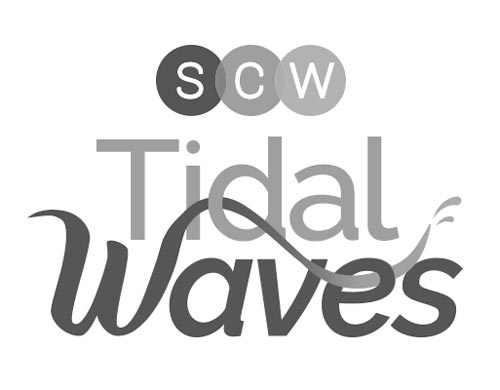
Strength Beneath the Surface
by Irene Pluim Mentz, PT
Water exercise continues to grow in popularity for all kinds of populations. It has often been referred to as Aquaerobics, which paints a certain picture in our minds of elderly women in the pool chatting with each other and moving around a bit. Slowly but surely that image is changing, and aquatic exercise programs are becoming more mainstream. People are realizing that taking their fitness habits to the pool has many advantages, but do they know what the benefits really are?
Anyone who teaches aquatic fitness already knows about joint unloading due to water buoyancy, reduced risk of falling or injury, and the extra resistance moving through the water. However, there are many more rewarding effects of aquatic fitness, and they all happen beneath the surface, not only the water, but also beneath the surface of your skin.
Maybe it is best to look at the main hydro-dynamic principle: the cohesion between water molecules which causes hydrostatic pressure, as well as resistance for moving objects because they must break through that interconnection. The human body is made up of systems and each individual body system can benefit from exercising in the water linking back to this “wanting to stick together” adherence between those molecules.
Let’s look individually at 10 major systems and breakdown how water pressure, caused by partial to almost full submersion, affects each of them.
> Cardiovascular system, consisting of heart, arteries, and veins. The venous return will be assisted with buoyancy and hydrostatic pressure. The heart rate remains slower when exercising in water, which for some populations is an added benefit.
> Integumentary system, the skin. The additional pressure helps even out tactile input, making it feel less fragmented; giving most people with sensory issues a calming, more collected sensation.
> Lymphatic system, the lymph nodes and veins. The hydro-static pressure of water all around the affected limb is more consistent than a pressure stocking or sleeve; and thus, very effective with diminishing swelling caused by lymphedema and hence improving the overall function of the lymphatic system, including its ability to fight infections
> Musculo-skeletal system, combination of our bones and muscles. The resistance provided by water causes us to use our muscles more, which in turn pull on the bones they are attached to, which increases calcium absorption and therefore strengthens our bones. So, the myth that water fitness does not help to build bone density has been debunked.
> Nervous system including brain, spinal cord, and nerves. The hydrostatic pressure effects our parasympathetic and sympathetic nervous system. Our “fight-flight’ response seems to calm down, especially when we are in warmer water. For people with brain injuries, spinal cord injuries and other peripheral or distal nerve issues; being in the water provides these individuals with opportunities to move, feel, and experience their environment more fully again.
> Urinary system which includes kidneys, bladder, and urinary tract. A small 10-year study on people with chronic kidney disease, suggested that low to moderate intensity aquatic exercise helped delay the need for dialysis and might decrease mortality. Think about all of those exercising in the pool; how quickly do many of them have to get out to go use the restroom….
> Respiratory system, the lungs and pulmonary veins. Another study was performed on subjects with COPD, divided into three groups: a control group, a floor exercise group, and an aquatic exercise group. Those in the aquatic exercise group showed the greatest strength increase for their respiratory muscles compared to both other groups. (I have personally worked with a client with muscular dystrophy, who was receiving aquatic therapy once a week. During this period he had no pneumonias, for several years, while in the years prior he would be hospitalized at least once a year.)
For all these observations, the studies found were small and often of short duration, but very promising as to the positive effects aquatic fitness can have, even for those “beneath the surface” body systems.
The following systems do not yet have enough research available and would greatly benefit from more. However, by thinking about these, we might be able to deduce some benefits (the following is just what I have seen and experienced with people I work with rather than on scientific research.)
> Digestive system, consisting of stomach, intestines, and liver. My opinion would be it probably would benefit the peristaltic movement, and possibly more so than regular activity on land.
> Endocrine system which are our glands and hormones and include part of our immune system. Just being in water has a calming effect for most, and I think aquatic exercise would improve overall functioning, including hormone levels and immune system.
> Reproductive systems. Hydrostatic pressure might have some effect on reproductive organs that are externally located, but again, there is no research available on this.
Are there some people for whom an aquatic environment might not work? Of course, and we will have to be sensitive to that. However, there are very few absolute contraindications and with proper assistance almost everybody can benefit from exercising in an aquatic environment.
For first-hand experience with the benefits of water exercise, visit me at SCW DC MANIA®, February 24-26 at the Hyatt Regency Dulles. I’ll be leading a session entitled “Strength Beneath the Surface”. You can also learn more about the new, affordable, unique Aqua Ohm resistance equipment on my website www.aqua-ohm.com. Come splash with me.
About the Author, Irene Pluim Mentz, PT

Irene PluimMentz became a licensed physical therapist in the Netherlands before immigrating to the United States. She is the co-owner of One Step Beyond, Inc. Physical Therapy. Irene’s passion for anything “water” led to becoming an AEA certified instructor. She integrates her knowledge of hydrodynamics with physical therapy into all of her sessions. Irene is the inventor and developer of the Aqua-Ω adjustable drag resistance water exercise equipment.
Aqua Fitness:
The Biggest Challenges for 2023
by Sara Kooperman, JD
As the world of aqua fitness (along with everyone else), continues to emerge from the pandemic, tides of change and many new challenges are washing up on the shores for clubs, managers, instructors, and participants. While some of these changes are being welcomed and are long overdue, others are presenting issues that may affect schedules, numbers, budgets, and the future of water exercise.
The biggest challenge managers will most likely face regarding aquatics fitness programs for 2023 is finding certified aqua instructors. When the pandemic hit, pools were closed. Therefore, many instructors left the industry, needing to find other sources of income and means of teaching. There is definitely a shortage of instructors despite the fact that facilities have reopened, and participants have returned. Knowledgeable Managers are also needed to maintain consistency with their programs. This means that if a program is called “aqua fit”, the class be taught should be consistent even when different instructors teach it. Students show up to take a class thinking it’s the same program they took on Monday (today is Wednesday), but because the instructor is different, the entire program has changed. Maintaining consistency between cueing references, physical demonstration, and musical selections is important. Using consistent and easy-to-follow choreography so the student does not feel lost in every class, will assist with growing your program attendance. The best thing to do in this situation is have the same instructor teach the same class at the same time, at least twice or three times a week. If this is not possible, work diligently to build a team of instructors that can encourage, support, and mentor each other. This may mean training land-based instructors willing to expand their teaching skills.
The biggest challenge for instructors of aquatic exercise in 2023 most likely will be finding an appropriate substitute instructor should they get sick, injured, or simply go on vacation. Finding an appropriate substitute can make or break a program. Students like consistency and high-quality and unless we can increase our instructor base by adding new instructors, we will be at a loss to maintain quality in our aquatic programs. if instructors can find a substitute when they need one, this substitute must be familiar not only with the program, but hopefully with the clientele as well. This means that an appropriate substitute must “take” the class at least once and be introduced to the students in the class. This is difficult to do financially. Do we pay the substitute instructor to simply attend the class? Do we require the substitute instructor to attend the class before they teach? These are difficult questions to address. The manager should have a plan in place for unforeseen situations. This might be as simple as videotaping each instructor’s program so that when a substitute is needed, even last minute, a video of the class can be forwarded to the substitute instructor. This at least will make the substitute instructor familiar with the regular instructor’s music, choreography, and cueing. It is not perfect, but at least the substitute instructor will be familiar with what is expected.
The biggest challenge in 2023 for students, is to find classes that are led by quality instructors on a consistent timetable. This all comes down to us, needing more instructors and requiring consistency and quality of teachers. Participants are flooding back to aquatic exercise. This is a safe and comfortable environment for individuals that have been sitting on the couch and possibly walking in a mall for the past 2 1/2 years. Also, with the trend towards wellness, more and more older adults, and out of shape individuals are seeking a comfortable exercise environment. Aquatics provides this environment. But if we don’t have enough instructors, and we don’t have enough classes on the schedule, this will frustrate our participants and they will most likely leave to find something else more suitable.
In summary, recovering from the pandemic requires quality instructors, consistent training, techniques, and attracting and maintaining certified teachers. One of the silver linings from the pandemic is that aquatic exercise offers the perfect environment for someone to begin a fitness regime. The buoyancy of the water and cool environment makes it a more comfortable venue for most exercisers. It might be suggested that students are encouraged to wear nylon T-shirts or long sleeve shirts over their bathing suits, which may serve to cover their bodies if they are intimidated or uncomfortable or become chilled easily.
Another silver lining is that finding certified instructors or getting your frontline students to get certified is easier than ever. There are live training options at every mania, fit pro instructor conferences, and live stream and online recorded Certifications. Aqua programs like LaBlast, Zumba, and WATERinMOTION®, offer pre-choreographed options, making it easy to learn and teach a variety of formats. Maintaining one’s certification and getting educated is easier now than ever. The pandemic accelerated all AI (Artificial Intelligenc) offerings. Zooming is easier than ever, recordings are of higher quality, and Certifications are more plentiful than ever.
2023 Promises to be the year of aquatics! Let’s hope everyone takes the plunge!
About the Author, Sara Kooperman, JD

Sara Kooperman, JD, CEO of SCW Fitness Education, WATERinMOTION®, and S.E.A.T. Fitness sits on the Gold’s Gym Think Tank and the canfitpro Advisory Panel and was a founding board member for the Women In Fitness Association (WIFA). Recently nominated for the IDEA Fitness Leader of the Year Award, Kooperman won the 2022 Most Innovating Fitness Pro by Fitness Industry Technology Council. She is also an inductee into the National Fitness Hall of Fame, an Illinois State Businesswoman of the Year, and an esteemed panelist for IHRSA’s Talks & Takes Monthly Talk Show.
Not Just a Vanity Issue
If belly fat has you down, know this: There is likely a medical reason you’re experiencing this stomach issue, and it’s making it hard to lose weight. Once you know why you have belly fat, you can start to solve the problem, and it’s not as difficult as you might think, according to scientific studies and experts like doctors who treat patients plagued with unwanted belly fat.
What Causes Belly Fat and How to Lose It
There’s good news and bad news about belly fat. The bad news is that, according to a recent government estimate, no fewer than 88 percent of the US population is walking around with belly fat, and most likely it is a symptom of insulin resistance.
Insulin resistance is a condition that can lead to type 2 diabetes since your body essentially stops listening to your insulin response to food, which makes you produce even more insulin, and this cycle continues until you either change your diet and get healthy, or the insulin production, which is essentially stuck in the “on” position, short circuits and your pancreas begins to wear out, which is essentially the state in which diabetes starts to happen.
The good news about belly fat? There are dietary changes, specifically a plant-based high-fiber diet strategy, that can help you reverse insulin resistance to lose weight, shrink belly fat, and get back on the road to being your healthiest.
Why Is Belly Fat so Bad for Your Health?
Belly fat isn’t just a vanity issue, but a sign of underlying health issues, which can become conditions that compromise your health, such as type 2 diabetes. So when belly fat shows up and acts stubborn, which it often does, and you find it hard to lose weight, you need to heed your doctor’s advice and do something about it. That’s the message from one MD we spoke to, who treats people with metabolic conditions, including obesity, diabetes, and insulin resistance. Here’s how to get rid of belly fat.
By changing your diet, and adopting a low-carb, high-fiber approach by eating more vegetables, fruit, legumes, nuts, seeds, and whole grains (and less processed foods such as refined grains like added sugar and white flour foods), you can reverse metabolic syndrome, which is a condition that includes insulin resistance, this doctor’s research has found.
Before you despair about what you can’t eat, or how hard it is to lose weight and belly fat, there are 22 foods that have been scientifically shown to help fight belly fat, and can even reverse insulin resistance, if you eat them daily, and avoid simple carbs (such as sugar, crackers, chips, sweets, and other processed foods) that drive up blood sugar.
You can get rid of both belly fat and lower your insulin resistance, and achieve overall health, just by avoiding processed foods and adding these 22 foods to your diet, and it works even better if you exercise daily. First, cut out added sugar, animal fat, and processed or fast foods that are full of the types of simple carbs that cause insulin to spike in the first place.
What Is Insulin Resistance and How Can You Reverse It?
Insulin resistance is a term that describes what happens when your body “stops listening” to insulin, so you create more and more of it, in an effort to get blood sugar to safely be used by the cells or carted away to be stored as fat. Insulin resistance is especially hard to solve since once the extra fuel (whether it’s sugar or fat) gets locked up, your blood sugar dips, and you sense that you’re hungry – even though you just ate not too long ago – and you eat again to satisfy the hunger cue. Then insulin goes up again, and your cells resist the signal, and as insulin gets ignored (or resisted) it pumps more and more, until finally there’s an answer.
Your blood can only hold a teaspoon of glucose or blood sugar at one time, so insulin is just trying to do its job to clear out the excess glucose before it can cause harm, but until you either fast or eat high-fiber foods, this ugly cycle continues, explains Dr. Cucuzzella, MD, author of the book Low-Carb on Any Budget. Insulin resistance–and excess belly fat–starts because your blood, all five liters of it, can only tolerate a finite amount of sugar in it, specifically the equivalent of a teaspoon or110 milligrams per deciliter, says Dr. Cucuzzella, who is a Family Medicine professor at West Virginia University School of Medicine.
When you eat more sugar or simple carbs (such as junk food, white bread, white pasta, sweets, chips or other highly processed foods) than your body can burn up by moving about, insulin response goes up, signaling to the body to store the extra fuel as fat. “Insulin knocks on the door” to tell your body that blood glucose needs to be delivered to the cells, first to the liver, muscles, and other cells, to be used for fuel, but then to your fat cells, where it can be stored till later.”
Things go awry when you eat more sugar than you can use, he explains. The average American meal has about 60 to 75 grams of carbohydrates in it. On average Americans eat about 250 to 300 grams of carbs a day, which is about ten times what your body can use–unless you’re training like an Olympic athlete. (Side note: Dr. Cucuzzella says he has eaten 20 to 30 grams of carbs a day for ten years, and as someone with diabetes, this level “keeps me well and running.”)
The more carbs you eat, the more insulin is released, causing insulin resistance
If you throw the typical meal with those 60 to 75 grams of carbs, then your insulin is going to do whatever it has to do to store the extra. Instead of knocking on the door, it is now pounding on the door, to alert the body that there is too much blood sugar, and it has to do something to get the body’s attention, so it starts rising and rising and rising. When those fat cells are full, the body says: enough! But insulin has to bang on the door even louder to get the body to listen and move that sugar out of our bloodstream.”
This back-and-forth signaling (the insulin getting louder, bullying the body to store extra glucose as fat, the body resisting this message since it has had enough), sends insulin higher and higher, and the body becomes more and more resistant to the message. The body just does not want to hear from insulin again and again, like a spam caller. It stops picking up.
A better way to phrase it is carbohydrate intolerance, which means your body does not hear or see the insulin. Your body eventually acts the way someone who is gluten intolerant acts when they eat wheat: You get inflamed, your immune system overwhelmed, and your gut reacts as if all these carbs are making it sick, which in fact they are.
Whether you eat plant-based or not you have to be conscious of added sugar and simple carbs. If you were peanut-allergic, you can’t eat them, but to someone who has central obesity, or who has insulin resistance, they are essentially carb allergic.
Only 12 percent of the population is “metabolically well,” Dr. Cucuzzella says, and for the other 88 percent with metabolic conditions, eating foods that help lower blood sugar is the key to shedding that unwanted belly fat, lowering the volume on insulin, and getting healthier.
What Is Metabolic Syndrome?
“The primary driver of belly fat and insulin resistance is excess sugar in the bloodstream, which comes from the food we eat,” such as excess carbohydrates, causing insulin resistance and creating a “metabolic storm” inside our bodies,” Dr. Cucuzzella explains.
As the metabolism breaks down, people develop a condition called metabolic syndrome, a cluster of conditions, which together act to increase your risk of heart disease, stroke, nonalcoholic fatty liver disease, and type 2 diabetes.
Given the implications associated with these conditions (increased blood pressure, high blood sugar, excess body fat around the waist, and a high cholesterol profile ), Dr. Cucuzzella has written an article, “Is It Time for a Lockdown on Sugar?,” published in the current issue of Clinical Journal of Sports Medicine.
Why is Belly Fat Dangerous?
Belly fat is more than just a cosmetic issue, he adds: “Belly fat or abdominal fat is the dangerous fat,” Dr. Cucuzzella says. “It’s called visceral fat, not brown body fat. We need brown fat as protection for vital storage. Women store differently than men, and more for endocrine function and for reproduction. But when you store it in the abdomen it increases the risk of heart disease and stroke. The primary driver of that apple shape is metabolic syndrome.
“Of the patients I see, 90 percent of them have it and they don’t know it. Essentially the body does not metabolize carbs the way it should. When you look at glucose per deciliter of concentration, they may not even eat more carbs than other people by the time they come to see me, but their body has become intolerant of the carbs they do eat.”
The problem is that if the liver is already filled and your muscles are filled (with the energy they need) and then you add more carbs and fat to the blood and over time, you have liver fat. . So not just sugar but the fat that comes with it, so now you have fat trapping. Insulin is a switch, which says store. So if you need to use that fat as fuel you need to reduce carbs and you can do that with a mostly plant-based diet.
Carbs are the primary driver of insulin. So to do this you have to lower insulin and if you do that you need to lower carbs. It’s not going to go away with a 30-day diet, he explains. Instead, the answer is to change your way of eating and to approach it as a lifestyle. You have to make that switch.
Reverse Metabolic Syndrome and Lose Belly Fat
The number one thing that Dr. Cucuzzella recommends to his patients is to follow a diet of low-carb, high-fiber foods, and to stick to eating real or whole foods. By doing this, it’s possible to lose belly fat and ultimately succeed at lasting weight loss.
“It’s really not anything extreme. It’s what your grandmother would eat: Nothing in a box or a bag with a label. Plenty of real food with carbs, but also high in fiber, so while a banana would qualify, it will behave differently in the body than leafy vegetables.”
Eating a diet high in fiber and low in carbs is the best way to combat and reverse insulin resistance, Dr. Cucuzzella says. Choose carbs that have fiber, like green leafy vegetables, and focus on getting as many of these high-fiber foods as you can, while cutting out the simple sugars and starchy foods.
“Fiber is magical. What fiber does is feeds the gut. Take zucchini for example. It might have six grams of carbs but 2 grams of that is fiber. That means the carbs in zucchini are not behaving like glucose in the body. The fiber will become food for the healthy bacteria in our gut. The same thing is true if I eat an apple, the carbs behave differently than apple juice with no fiber. Fiber feeds the healthy trillions of bacteria in the gut and helps to fight obesity and heart disease, and it makes you feel full.
“We don’t understand all the ways that the microbiome helps keep us healthy,” says Dr. Cucuzella, “but we know that feeding it vegetables, and high-fiber foods such as greens, can help reverse disease and lower insulin. Simply said, eat fiber, in the colors of the rainbow, to provide nourishment to the microbiome and lower your insulin response to the food you eat.”
Why It’s So Important to Eat Fewer Simple Carbs
Carbs create inflammation explains Dr. Cucuzzella, which is dangerous when you get sick from the flu or other virus. “I work in a hospital so people in the hospital often have these conditions associated with insulin resistance, which is obesity and hypertension, and diabetes. If you want to protect yourself from the flu or the next wave of COVID-19, get healthy now. You can lower the chances of having complications or severe symptoms if you get healthy now by maintaining a low-carb diet.
“If you are ever in hospital you need to have the host or body be healthy to fight the infection. The cytokine storm causes hyperglycemia. And when we have hyperglycemia our whole immune system function is disabled and it starts a cascade of negative effects. We don’t have a good treatment for the cytokine storm yet. You have to ride it out. The people who have it the worst are people with some spectrum of high blood sugar or metabolic syndrome.”
The 22 foods to eat to help lower insulin resistance
Here is Dr. Cucuzzella’s list of non-starchy plant foods that he gives to his patients, from his book, Low Carb on Any Budget. It should not be expensive to eat healthily. He calls it the Green Food list. Eat these to help lower insulin resistance and lose stubborn belly fat.
- Avocado
- Asparagus
- Bell Pepper
- Brussels Sprouts
- Cabbage
- Cauliflower
- Cucumber
- Green Onions
- Jalapeño
- Mushrooms
- Olives
- Onion
- Pickles
- Romaine Lettuce
- Spinach
- Sauerkraut
- Tomatoes
- Zucchini
- Macadamia Nuts
- Almonds
- Walnuts
Pecans
Bottom Line: Stubborn Belly Fat Could Be a Sign of Insulin Resistance. Here Are 22 Foods to Fight Back
Belly fat may be a sign that you are battling with insulin resistance, a potentially dangerous condition that can lead to diabetes, according to this doctor. To fight back and get rid of stubborn belly fat, and reverse your insulin resistance, eat these 22 foods that are part of a high-fiber diet rich in vegetables, legumes, fruit, and whole grains, and avoid highly-processed foods that cause insulin levels to spike.

Have a Whale of a Time at DC MANIA®
We are so excited to see you at our first event of the new year, DC MANIA®, February 24-26, at the Hyatt Regency Dulles. With aqua sessions from LaBlast®, WATERinMOTION®, and Aqua-Ohm™, as well as our fabulous SCW presenters like Irene McCormick, Marybeth Dziubinski, and Billie Wartenberg you are sure to rise on the tide and make a huge splash with your water participants.
Looking to Hire? FREE Job Board
In Need of Teachers, Trainers, Directors, or Managers? SCW’s new FREE JOB BOARD is supporting the industry’s need for qualified fitness pros.
Best of all there is NO COST to you. We will post your openings in all three of our monthly e-newsletters: Spotlite, Health & Fitness Business News, and Tidal Waves which are emailed out to tens of thousands of fitness professionals teaching and training in all formats along with managers and directors at all fitness facilities: big box, gyms, boutique, studios, not for profits and independent centers.
We’re always looking for great content highlighting the newest things in the world of aquatic fitness. Please submit your article directly to editor@scwfit.com for immediate consideration!
Give us your feedback on what interests you, and maybe YOU will make it in the SCW Tidal Waves!
Tidal Waves, January 2025
Tidal Waves, November 2024
Tidal Waves, October 2024
Tidal Waves, June 2024
Tidal Waves, May 2024
Tidal Waves, April 2024
Tidal Waves, March 2024
Tidal Waves, February 2024
Tidal Waves, January 2024
Tidal Waves, December 2023
Tidal Waves, November 2023
Tidal Waves, October 2023
Tidal Waves, September 2023
Tidal Waves, August 2023
Tidal Waves, July 2023
Tidal Waves, June 2023
Tidal Waves, May 2023
Tidal Waves, April 2023
Tidal Waves, March 2023
Tidal Waves, January 2023
Tidal Waves, November 2022
Tidal Waves, September 2022
Tidal Waves, July 2022
Tidal Waves, June 2022
Tidal Waves, May 2022
Tidal Waves, April 2022
Tidal Waves, March 2022
Tidal Waves, February 2022
Tidal Waves, January 2022
Tidal Waves, November 2021
Tidal Waves, October 2021
Tidal Waves, August 2021
Tidal Waves, July 2021
Tidal Waves, June 2021
Tidal Waves, May 2021
Tidal Waves, April 2021
Tidal Waves, March 2021
Tidal Waves, January 2021
















